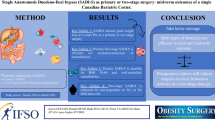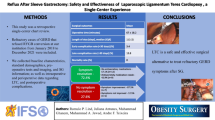Abstract
Background
Outcomes are not well studied in patients undergoing remediation for multi-fundoplication failure, that is, two or more prior failed fundoplications. Re-operation must balance reflux control and restoration of the ability to eat with the challenge of reconstructing a distorted hiatus and GE junction. The purpose of this study is to present our experience with surgical remediation for multi-fundoplication failure.
Methods
Medical records were retrospectively reviewed of 91 patients who underwent third time or more esophagogastric operation for fundoplication failure at a single institution from 2007 to 2016. Dysphagia was present in 56% and heartburn in 51%. Median number of prior operations was 2 with range up to 6. Anatomic failure consisted of slipped wrap in 26 cases, wrap herniation in 23, hiatal stenosis in 24, hiatal mesh complication in 8, and wrap dehiscence in 10. Operative approaches generally followed an institutional algorithm and consisted of hiatal hernia repair with: re-do fundoplication in 55%, takedown of fundoplication alone in 24%, Roux-en-Y gastrojejunostomy in 14%, and GE junction resection in 7%. Laparoscopic approach was successful in 81%.
Results
Mean duration of operations was 217 min and median length of stay was 3 days. The complication rate was 13%, with 7% undergoing unplanned early re-operation. Patients were followed for mean 11 months, and recurrent hiatal hernia was detected in 13%. Late re-operation was performed in 6% for recurrent hiatal hernia. Recurrent reflux symptomatology resolved in 93%. Dysphagia resolved in 84%. There were no significant differences in outcomes with regard to number of prior operations, operative approach, BMI, or age.
Conclusions
There is no single best approach to remediation in the multi-fundoplication failure patient. Re-do fundoplication is appropriate in over half of patients. Reoperation for multi-fundoplication failure can be performed via minimally invasive approach with excellent remediation of symptoms, low morbidity, and low recurrence rates.

Similar content being viewed by others
References
Robinson B, Dunst CM, Cassera MA, Reavis KM, Sharata A, Swanstrom LL (2015) 20 years later: laparoscopic fundoplication durability. Surg Endosc 29(9):2520–2524
Heikkinen TJ, Haukipuro K, Koivukangas P, Sorasto A, Autio R, Södervik H, Mäkelä H, Hulkko A (1999) Comparison of costs between laparoscopic and open Nissen fundoplication: a prospective randomized study with a 3-month followup. J Am Coll Surg 188(4):368–376
Ruiz-Tovar J, Diez-Tabernilla M, Chames A, Morales V, Martinez-Molina E (2010) Clinical outcome at 10 years after laparoscopic versus open Nissen fundoplication. J Laparoendosc Adv Surg Tech A 20(1):21–23
Hinder RA, Klingler PJ, Perdikis G, Smith SL (1997) Management of the failed antireflux operation. Surg Clin North Am 77(5):1083–1098
Smith CD, McClusky DA, Rajad MA, Lederman AB, Hunter JG (2005) When fundoplication fails: redo? Ann Surg 241(6):861–869 (discussion 869–871)
Furnée EJ, Draaisma WA, Broeders IA, Gooszen HG (2009) Surgical reintervention after failed antireflux surgery: a systematic review of the literature. J Gastrointest Surg 13(8):1539–1549
Van Beek DB, Auyang ED, Soper NJ (2011) A comprehensive review of laparoscopic redo fundoplication. Surg Endosc 25(3):706–712
Little AG, Ferguson MK, Skinner DB (1986) Reoperation for failed antireflux operations. J Thorac Cardiovasc Surg 91(4):511–517
Makris KI, Panwar A, Willer BL, Ali A, Sramek KL, Lee TH, Mittal SK (2012) The role of short-limb Roux-en-Y reconstruction for failed antireflux surgery: a single-center 5-year experience. Surg Endosc 26(5):1279–1286
Mittal SK, Légner A, Tsuboi K, Juhasz A, Bathla L, Lee TH (2013) Roux-en-Y reconstruction is superior to redo fundoplication in a subset of patients with failed antireflux surgery. Surg Endosc 27(3):927–935
Awais O, Luketich JD, Reddy N, Bianco V, Levy RM, Schuchert MJ, Gooding WE, Crist LR, Landreneau RJ, Pennathur A (2014) Roux-en-Y near esophagojejunostomy for failed antireflux operations: outcomes in more than 100 patients. Ann Thorac Surg 98(6):1905–1911. (discussion 1911–1913)
Singhal S, Kirkpatrick DR, Masuda T, Gerhardt J, Mittal SK (2018) Primary and redo antireflux surgery: outcomes and lessons learned. J Gastrointest Surg 22:177–186
Terry ML, Vernon A, Hunter JG (2004) Stapled-wedge Collis gastroplasty for the shortened esophagus. Am J Surg 188(2):195–199
Makdisi G, Nichols F, Cassivi S, Wigle D, Shen R, Allen M, Deschamps C (2014) Laparoscopic repair for failed antireflux procedures. Ann Thorac Surg 98:1261–1266
Stadlhuber RJ, Sherif AE, Mittal SK, Fitzgibbons RJ Jr, Brunt LM, Hunter JG, Demeester TR, Swanstrom LL, Smith CD, Filipi CJ (2009) Mesh complications after prosthetic reinforcement of hiatal closure: a 28-case series. Surg Endosc 23(6):1219–1226
Parker M, Bowers SP, Bray JM, Harris AS, Belli EV, Pfluke JM, Preissler S, Asbun HJ, Smith CD (2010) Hiatal mesh is associated with major resection at revisional operation. Surg Endosc 24(12):3095–3101
Oelschlager BK, Pellegrini CA, Hunter JG, Brunt ML, Soper NJ, Sheppard BC, Polissar NL, Neradilek MB, Mitsumori LM, Rohrmann CA, Swanstrom LL (2011) Biologic prosthesis to prevent recurrence after laparoscopic paraesophageal hernia repair: long-term follow-up from a multicenter, prospective, randomized trial. J Am Coll Surg 213(4):461–468
Antiporda M, Veenstra B, Jackson C, Kandel P, Daniel Smith C, Bowers SP (2018) Laparoscopic repair of giant paraesophageal hernia: are there factors associated with anatomic recurrence? Surg Endosc 32(2):945–954
Author information
Authors and Affiliations
Contributions
All listed authors made substantial contributions to the conception and design of this work as well as acquisition, analysis, and interpretation of data. All revised critically for important intellectual content. All gave final approval for publishing. All agree to be accountable for all aspects of the work to ensure questions related to accuracy/integrity of any part are appropriately investigated and resolved.
Corresponding author
Ethics declarations
Disclosures
Drs. Michael Antiporda, C. Daniel Smith, Mathew Thomas, Enrique Elli, Steven P. Bowers, and Ms. Chloe Jackson have no relevant conflicts of interest or financial ties to disclose.
Rights and permissions
About this article
Cite this article
Antiporda, M., Jackson, C., Smith, C.D. et al. Strategies for surgical remediation of the multi-fundoplication failure patient. Surg Endosc 33, 1474–1481 (2019). https://doi.org/10.1007/s00464-018-6429-0
Received:
Accepted:
Published:
Issue Date:
DOI: https://doi.org/10.1007/s00464-018-6429-0




